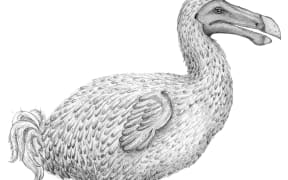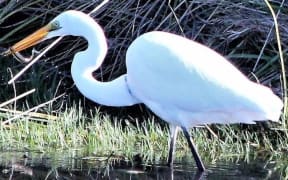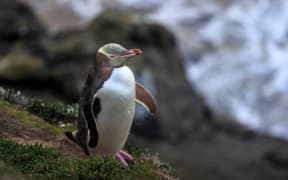A curious game of aerial ping-pong is playing out in the Pureora Forest Park in the central North Island as part of a project to re-establish kokāko hundreds of kilometres away in Taranaki.
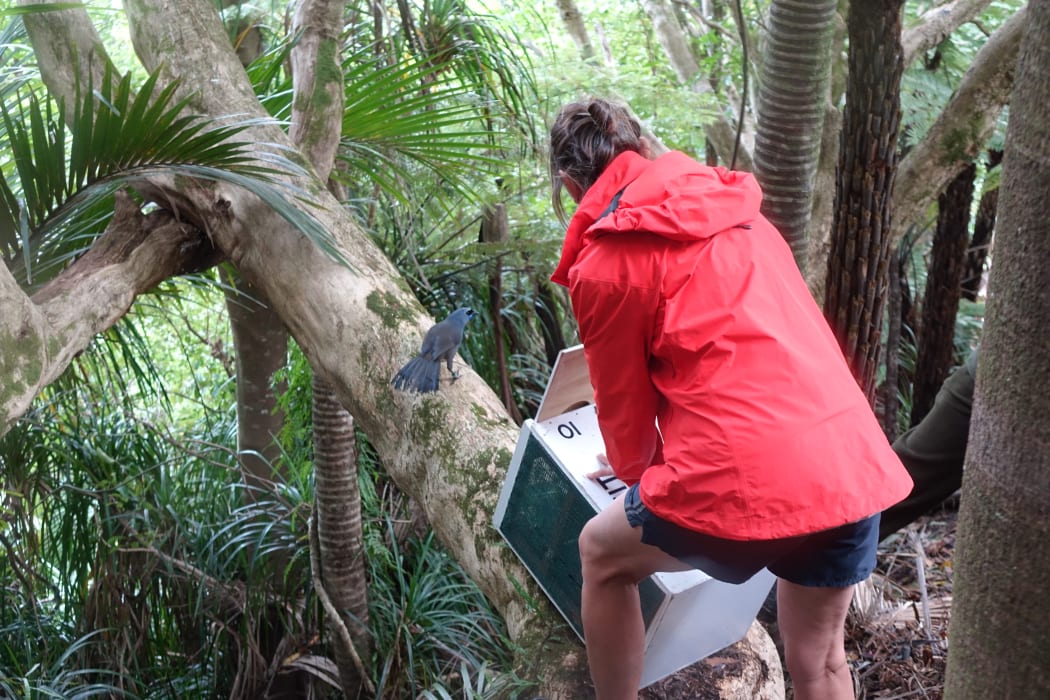
The bird is released at Parininihi Photo: RNZ / Robin Martin
Nine birds have been recovered from the park this autumn and taken to the Parininihi Forest near Tongaporutu to increase the genetic diversity of the 20 kokāko re-introduced there last year.
Ecologist and kokāko specialist Dave Bryden said Pureora was playing a vital role in stabilising the endangered species' numbers.
"Pureora is really important for kokāko nationally. The population of kokāko is so large here that in the last four years we've been able to take 100 birds out of Pureora and use them to establish kokāko in sites where they used to be," Mr Bryden said.
The recovery mission begins deep in the Mangatutu Ecological Area shortly after dawn when the birds are at their most active.
Predator bait stations - supported by regular 1080 drops - were first laid at Mangatutu in 1995 when there were just seven kokāko pairs.
There are now more than 185 pairs in the ecological block and 450 pairs throughout the forest park -- a quarter of the North Island kokāko's entire population.
Mr Bryden and his team have targeted a responsive pair of kokāko and selected a clearing where they have erected a net, high in the tree tops.
"You can see there's a windfall that's come down here, an old tree that's fallen down and created a nice little gap which we know the kokāko - which are poor fliers - like to jump through," said Mr Bryden.
"Then it's just a case of clearing the understorey and firing lines over the top. We use two ounce sinkers and fire them using slingshots so it's a lot of fun firing the lines over the trees and we use to those pull up the ropes and over those we pull up the net."
The net is imported from the United States.
"The net is specially designed for catching kokāko and other larger birds -- the smaller birds will actually fly straight through it -- but the larger kokāko will hit the net and every 40cm there's what we call a tramel line and that creates a pocket on the net and when the bird hits the net it will fall into the pocket."
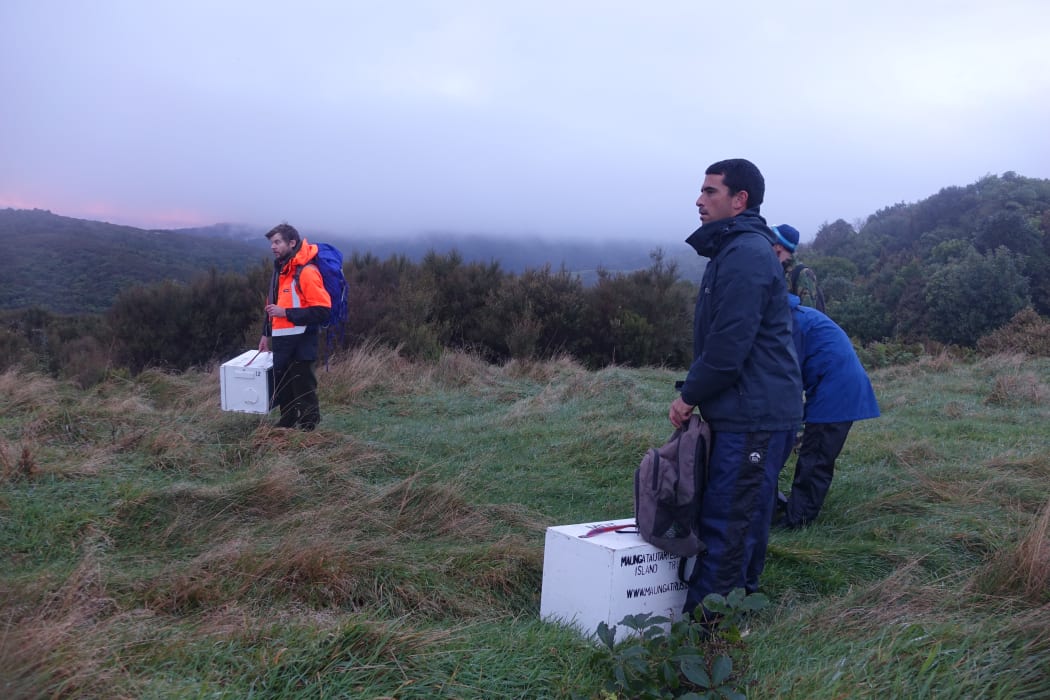
The recovery team prepare to enter the forest. Photo: RNZ / Robin Martin
Mr Bryden said the experience was not too uncomfortable for the bird.
"Hopefully not. It is usually more traumatic for us than the bird. They usually just get a little bit of a fright."
With the net in place, what Mr Bryden describes as a "ping-pong" game begins.
Armed with a digital device loaded with hundreds of kokāko calls, Mr Bryden uses speakers set in the trees either side of the net and a hand-held "boom box" to lure the birds across the clearing.
"Ideally we're playing just playing ping-pong with the birds. If they're on the lefthand side of the net we play the speaker from the righthand side and what we're doing is playing their calls back to them.
"And then because kokāko are territorial, it means that the birds think there is an intruder in their territory and they'll come to investigate."
The response to the bird's organ-like call, which ends in a distinctive "tuk, tuk", is almost instantaneous as the kokāko pair hop through the tree tops to check out who is in their neighbourhood uninvited.
But that doesn't mean their capture is going to be easy... it's almost an hour before the female falls for the ruse.
Amanda Rogers, Mr Bryden's colleague, said it was unusual to get the female first.
"This is really lucky. It's really easy to get the male birds first because they tend to lead the females around so he went over the top of the net and she was a little behind him and we got her."
The bird is processed almost immediately.
"From a combination of weights, tarus length and wing chord, which is a sort of wing measurement, we are trying to get an idea whether it is a male or a female.
"So far from its weight this bird could be either so we'll send a couple of feathers off to Massey and they'll tell us for sure," Ms Rogers said.
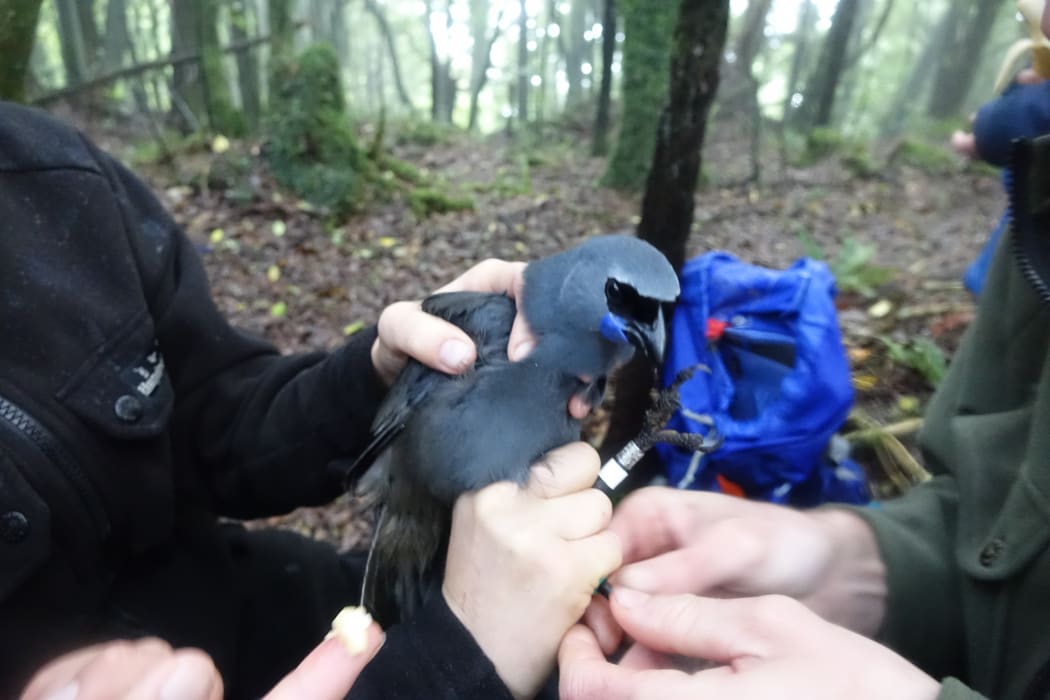
The female is processed soon after being caught. Photo: RNZ / Robin Martin
The captured bird has to be released within five hours so the team has a little more than 30 minutes to try and get the male.
It's not to be... but Ms Rogers isn't too worried that the male will be single for long.
"There's a lot of single birds around so I'm sure he won't be too broken-hearted. At Parininihi at the moment there are six pairs and only two of them were translocated as pairs. The others have either found new mates or swapped partners so we don't get too sentimental about it."
It's a poignant moment for Auckland volunteer Mikey Watson however.
An ecologist himself, an early encounter with kokāko influenced his eventual career choice.
"So, when I was eight years old and I remember being on Tiritiri Matangi and seeing two kokāko in the trees and they were jumping around like monkeys and that really caught my attention and so I got into conservation ... went from dinosaurs to conservation."
Meanwhile, secured in a truck, the likely female is ready for the drive to Parininihi.
Four hours later she's released on the coastal fringe of the park, hops quietly out onto the bough of a tree and takes a brief look at her new home before taking her leave.
Mr Watson could not have been more chuffed.
"Considering tomorrow I turn 28. That's 20 years [since that first encounter] so it's a pretty special event to mark that so I'm very happy, very happy."
Of the 20 kokāko released on behalf of Ngāti Tama's Tiake Te Mauri O Parininihi Trust last year, 15 have been sighted again since.
Six have formed pairs and four fledglings have been raised.
Kokāko fact file
- 1900 - number of kokāko pairs across the North Island
- 450 - number of kokāko pairs in the Pureora Forst Park
- 10-15 number of years kokāko pair stays together
- 25 years - lifespan of kokāko
- 100 metres - seldom flies further
- Their diet consists of leaves, fern fronds, flowers, fruit and invertebrates
